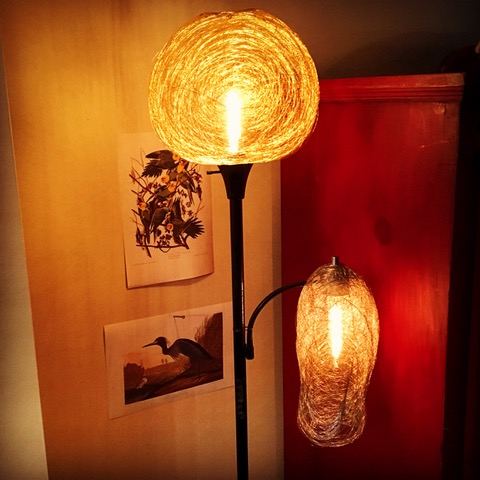The following piece appears in the Fall issue of an EDM wire industry magazine, called EDM Today.
A few months ago I was at the EDM Tech Center, in Minnesota, where I noticed a peculiar floor lamp in the lobby. It consisted of two bulbs inside two different shades, each made from sparkling gold EDM wire. I asked about the lamp, and was told it was made by a Michigan-based artist, named Mike O’Reilly. I had to track this guy down to get his story, and he was happy to tell it.
Couldn't do it without reliable contacts in the EDM wire industry
“I get great satisfaction by showing my work to people in the EDM industry, because you guys understand the properties of this material.” He told me. “Doesn’t matter if you’re into art, or not, EDM wire industry people see the technical reasons why brass wire works for what I’m doing, and why other kinds of wire don’t. I appreciate that, and I want to give a shoutout to Jerry Dillon, from EDM Tech Center, in Minnesota, and the guys down the street, at Belmont EDM. Both suppliers have been great to me, even though I’m not exactly their biggest customer.”
Mike O’Reilly grew up outside of Detroit, a place known for its creative spirit, and the infusion of that creativity into the cars and other products that made Motown an industrial success story. His Mom is an art school grad and former gallery owner, and his father is a film buff and businessman. The path O’Reilly has taken certainly resembles a combination of those traits, having started a backpack company, while earning his masters degree in creative writing, from the University of Utah. He’s a published author of poetry, screenplays and works of nonfiction. The creation of visual art, however, is new terrain for O’Reilly.
“I came across this stuff completely by accident, just a few years ago,” the 43 year-old recalls. “I didn't even know the EDM wire industry existed, until I saw a pile of used wire at the metal recycling center, and a flash went through my head. I looked at the way it was piled there, like human hair on a pallet, dirty but sparkling. I was struck by the fact there were no kinks in it. I scooped up a few pounds, and drove away with the feeling that this wire had some sort of art/design potential, I just didn’t know what it was. I really had no desire to get literally tangled up in a new hobby. “Wire art,” in general, didn’t even excite me. At first, my main motivated was the fact that I had never seen anything made out of brass wire. During that period, working with EDM wire was a frustrating puzzle. As I refined my technique, however, it became a relaxing way to spend my time.”
While O’Reilly uses an industrial material, the end result is distinct from what we’ve come to know as “industrial art.” There are no big machine gears or pipes, no jagged bits of glass, no big chunks of iron welded together. His process resembles something closer to that of a fiber artist, than a metalworker. He explains how his art became driven, not by his own creative visions, but by his bizarre fascination with a material that behaves in the exact opposite way you’d expect it to. For example, when soft copper is wrapped around object, and maintains the object’s shape, forces of compression are at play. EDM wire, however, when wrapped around an object will spring outward, resisting all curves and bends. 3D shapes made from hard brass wire are thus relying on forces of tension rather than compression to maintain their structure.
“The thing about copper or soft steel wire,” he says, “is that you can basically make any shape you want out of it. If you want a duck or a flower, you can take some pliers and make one. That’s not what I’m trying to do. I’m working within a different set of parameters and physical properties. Those rules are what I like about with EDM wire. At first I did some abstract stuff with the used wire I bought, but then I started buying brand new spools, and experimented with different alloys, diameters and brands. I went on a systematic, year-long quest to figure out an efficient process for working with EDM wire. Finally, I mastered a few fundamental techniques for making flat wire panels, spheres, bowls and tube shapes. Only then did I return to more abstract designs.”
Although O’Reilly sells his custom artwork under his own name, he created Brightwire Designs as a brand defined by two distinct catalogs; one featuring lighting products, and the other a collection of home decor pieces. O’Reilly works with different design groups for each product line. On the decor side of things, he’s represented by the Rita O’Brien Design Group, operating out of the Michigan Design Center. His lights can be found on display and purchased from Royal Oak, Michigan’s Whiski Kitchen design studio.

